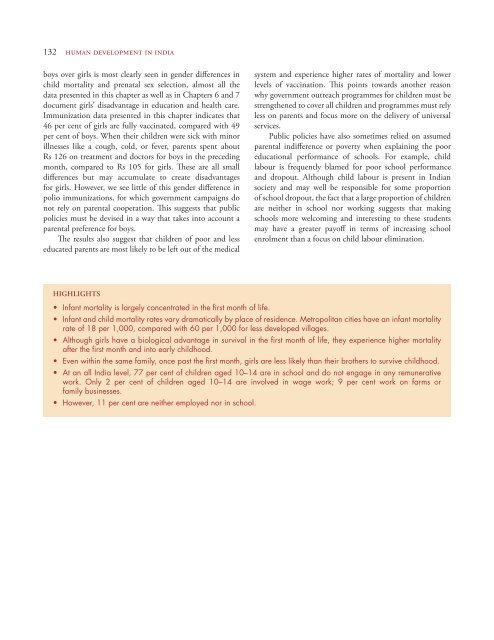Human Development in India - NCAER
Human Development in India - NCAER
Human Development in India - NCAER
You also want an ePaper? Increase the reach of your titles
YUMPU automatically turns print PDFs into web optimized ePapers that Google loves.
132 human development <strong>in</strong> <strong>in</strong>diaboys over girls is most clearly seen <strong>in</strong> gender differences <strong>in</strong>child mortality and prenatal sex selection, almost all thedata presented <strong>in</strong> this chapter as well as <strong>in</strong> Chapters 6 and 7document girls’ disadvantage <strong>in</strong> education and health care.Immunization data presented <strong>in</strong> this chapter <strong>in</strong>dicates that46 per cent of girls are fully vacc<strong>in</strong>ated, compared with 49per cent of boys. When their children were sick with m<strong>in</strong>orillnesses like a cough, cold, or fever, parents spent aboutRs 126 on treatment and doctors for boys <strong>in</strong> the preced<strong>in</strong>gmonth, compared to Rs 105 for girls. These are all smalldifferences but may accumulate to create disadvantagesfor girls. However, we see little of this gender difference <strong>in</strong>polio immunizations, for which government campaigns donot rely on parental cooperation. This suggests that publicpolicies must be devised <strong>in</strong> a way that takes <strong>in</strong>to account aparental preference for boys.The results also suggest that children of poor and lesseducated parents are most likely to be left out of the medicalsystem and experience higher rates of mortality and lowerlevels of vacc<strong>in</strong>ation. This po<strong>in</strong>ts towards another reasonwhy government outreach programmes for children must bestrengthened to cover all children and programmes must relyless on parents and focus more on the delivery of universalservices.Public policies have also sometimes relied on assumedparental <strong>in</strong>difference or poverty when expla<strong>in</strong><strong>in</strong>g the pooreducational performance of schools. For example, childlabour is frequently blamed for poor school performanceand dropout. Although child labour is present <strong>in</strong> <strong>India</strong>nsociety and may well be responsible for some proportionof school dropout, the fact that a large proportion of childrenare neither <strong>in</strong> school nor work<strong>in</strong>g suggests that mak<strong>in</strong>gschools more welcom<strong>in</strong>g and <strong>in</strong>terest<strong>in</strong>g to these studentsmay have a greater payoff <strong>in</strong> terms of <strong>in</strong>creas<strong>in</strong>g schoolenrolment than a focus on child labour elim<strong>in</strong>ation.HIGHLIGHTS• Infant mortality is largely concentrated <strong>in</strong> the first month of life.• Infant and child mortality rates vary dramatically by place of residence. Metropolitan cities have an <strong>in</strong>fant mortalityrate of 18 per 1,000, compared with 60 per 1,000 for less developed villages.• Although girls have a biological advantage <strong>in</strong> survival <strong>in</strong> the first month of life, they experience higher mortalityafter the first month and <strong>in</strong>to early childhood.• Even with<strong>in</strong> the same family, once past the first month, girls are less likely than their brothers to survive childhood.• At an all <strong>India</strong> level, 77 per cent of children aged 10–14 are <strong>in</strong> school and do not engage <strong>in</strong> any remunerativework. Only 2 per cent of children aged 10–14 are <strong>in</strong>volved <strong>in</strong> wage work; 9 per cent work on farms orfamily bus<strong>in</strong>esses.• However, 11 per cent are neither employed nor <strong>in</strong> school.















